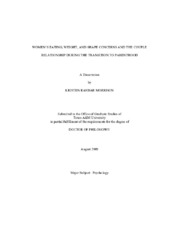| dc.description.abstract | The transition to parenthood brings a host of changes to new parents; two key
areas of change are decreases in relationship functioning and a worsening of women's
eating, weight, and shape (EWS) concerns. Past research has suggested that a
connection may exist between women's EWS concerns and relationship functioning
during this transition. This study explored the impact of women's EWS concerns on
both partners' relationship functioning in a sample of 74 couples (148 individuals)
having their first baby. The study was part of a larger project exploring interventions
during the transition to parenthood; thus, all couples had at least one risk factor for
future relationship problems. Participants completed questionnaires approximately
seven months into pregnancy and at one and three months postpartum.
Results revealed that relationship functioning and women's EWS concerns
worsened from pregnancy to three months postpartum, which is consistent with previous
literature. Changes in women's EWS concerns from before and during pregnancy to
three months postpartum were not generally related to changes in either partner's
relationship functioning during the same period. However, the EWS concerns that predicted poorer relationship outcomes, including women's drive for thinness and
bulimia symptoms, suggest the possible role of third factors such as negative affect or
neuroticism. Also, increases in women's Body Mass Index from pre-pregnancy to three
months postpartum predicted increases in relationship functioning, indicating the
possibility of a larger construct such as general acceptance of the post-birth process, both
in terms of weight changes and relationship changes. Thus, preventive efforts could
include an emphasis on helping partners to accept the changes they will experience
during this transition. Finally, the significant relations between women's EWS concerns
and relationship functioning were often mediated by men's reported frequency of sexual
activity, suggesting the importance of sex as a mediator. Although findings were
limited, the results should be interpreted in light of previous research and the current
study's limitations. Overall, this study indicates the need for future research exploring
the relations between women's EWS concerns and the couple relationship during the
transition to parenthood. | en |


